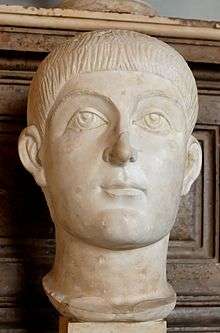Traianus (magister peditum)
Traianus (died August 9, 378 at Adrianople) was a Roman general under Emperor Valens with whom he died in the battle of Adrianople.
Life

Between 367 and 368 he held the military office of dux Aegypti. While in office, he and the praefectus augustalis Eutolmius Tatianus protected the Arian bishop Lucius of Alexandria. He was also ordered to rebuild the Caesareum and he started the building on May 1, 368.
Between 371 and 374 he was comes rei militaris in the East, where, together with the Alamannic king Vadomarius he fought the Sasanids. At the end of the winter, the Sasanid king Shapur II gathered his army and moved against the Roman territory. Emperor Valens sent Vadomarius and Traianus against him, with a strong army and the order to keep the Sasanids under control but to avoid provoking them into battle. However, at Vagabanta the Sasanid cavalry forced the Roman infantry into contact: the infantry first tried to break contact, but then defeated the enemy. The following encounters had alternate results and so, at the end of summer, the generals signed a truce and retired.[1] In 374, while he commanded the Roman troops in Armenia, he was secretly ordered by Valens to kill king Papas (Pap). Traianus obtained Papas' confidence and invited him to dinner: during the banquet, Traianus left the room and a killer killed Papas.[2]
Later he was promoted to the rank of magister peditum and was sent in Thracia to fight the Gothic War. In 377 the Goths had been allowed to enter Roman territory but, oppressed by Roman officers, had rebelled and had sacked Adrianople, gathering under the leadership of Fritigern. Emperor Valens was at the time at Antioch, in Syria, where he was preparing the war against the Sasanids. The Emperor decided to send two of his generals, Profuturus and Traianus, to Thracia with fresh troops. The two generals decided to fight the bulk of the enemy army with their Armenian troops, which had proved valiant, and succeeded in pushing the Goths inside the valleys, where they hoped to defeat them by hunger. The Roman troops were, nonetheless, vastly inferior by number to the Goths, and, since the expected reinforcements led by Frigeridus did not arrive, Traianus and Profuturus decided to retire and to unite to the units of Richomeres near the city of Ad Salices ("Near the Willows", close to Marcianopolis in Moesia). Here the Romans and the Goths fought the battle of the Willows: the Romans fought a huge number of Goths (Gothic soldiers with their families) who had entrenched behind a wall of wagons, then forced them to open-field battle. At first the Roman left wing broke, but thanks to the reinforcement of local troops, the Romans were able to sustain the fight until the night came, despite receiving huge losses.[3]
When the news of the bloody battle arrived in the East, Valens sent West more troops under the magister equitum Saturninus, who was to substitute the two generals.[4] When he returned to Constantinople, Valens accused Traianus of cowardice, but thanks to the support of the magistri militum Arinthaeus and Victor, Traianus put the blame on Valens' persecution of the Nicenians.
In 378 Traianus was exonerated in favour of Sebastianus,[5] but he was later recalled in service. Traianus followed Valens, who wanted to defeat the Goths before the arrival from the West of his nephew Gratian with the Western army.[6] Valens fought the Goths in the battle of Adrianople (August 9, 378); here, while the Roman troops were shattering around, Traianus noted that the Emperor had been left alone by his guards, and the two of them fell on the battlefield.[7]
Notes
- Ammianus Marcellinus, XXIX I,2-4.
- Ammianus Marcellinus, XXX I,18-21.
- Ammianus Marcellinus, XXXI VII,1-16.
- Ammianus Marcellinus, XXXI VIII,3.
- Ammianus Marcellinus, XXXI XI,1.
- Ammianus Marcellinus, XXXI XII,1.
- Ammianus Marcellinus, XXXI XIII,8,18.
Sources
- Jones, Arnold Hugh Martin, John Robert Martindale, John Morris, "Traianus 2", The Prosopography of the Later Roman Empire, volume 1, Cambridge University Press, 1992, ISBN 0-521-07233-6, pp. 921–922.